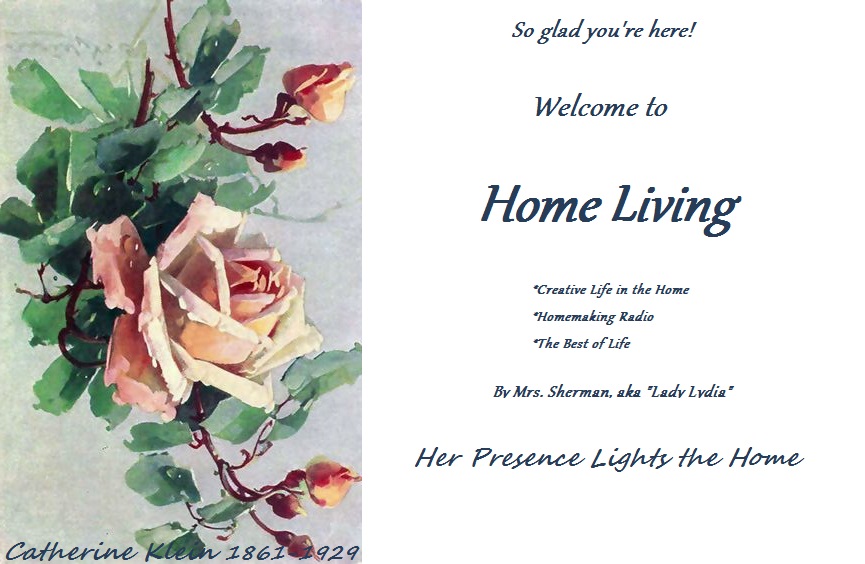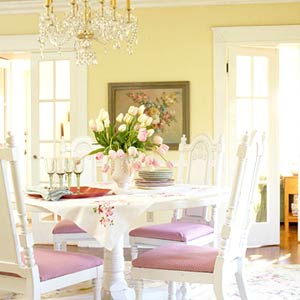



We've been reading about house-building in America in the early 1900's. The President of the U.S., along with others, developed a plan for smaller homes to be built so that everyone could have a house. If you got the houseplans, nine other little booklets were included, dealing with landscaping, gardening, interior decorating and home improvement. They were considered "small" because they were a departure from the grand Victorian homes of the 1800's, but by todays standards, they are large. After reading this article, you may begin to notice quite a few of these houses in your town. These were also called "bungalows," miniature Victorians, and miniature southern colonial.
This blue house is from http://www.bearcreekstudio.com/images/house1.jpg
President Harding, at the dedication of the "Home Sweet Home" at Washington, stated:
"The home is at last not merely the center, but truly the aim, the object and the purpose of all human organization. We do not see to improve society in order that from better homes we may bring forth better servants of the state, more efficient cannon fodder for its armed forces; rather, we seek to make better homes in order that we may avoid the necessity for conflict and turmoil in our world.
"The home is the apex and the aim, the end rather than the means of our whole social system. So far as this world knows or can vision, there is no attainment more desireable than the happy and contented home."
(Interior sketches from http://www.historictempletonmccanlessdistrict.com/interiors.php)
From a newspaper of the year of this housing project; (Can you imagine a newspaper writing this today?"):
"Of the man's part in the building of a home, all that the normal man does, in the struggle for life, is really that he may have a happy home, wehre he can rear his family, give them such advantages as his means can afford, and start them in their own lives with such aid as will best help them.
"The crowning joy of the typical man is in the home, to which he can repair when his day's work is done.
"But whatever the joy which the man gets from a happy home, it pales into insignificance when compared with the radiance which it brings to the soul of the gracious personage who, by her own competence, her own self-sacrifice, and out of the depths of such love as is beyond the comprehension of any man, makes the home what it is, and where she reigns supreme.
"No other ideal has the beauty of the ideal home. No other purpose can be nobler than increasing their number and their comfort. No other theme could be more inspiring."
More information here from other sources:
The Better Homes Campaign
Better Homes in America, Inc., a private organization founded in 1922, spearheaded a national campaign for domestic reform focused on educating homeowners about quality design and construction. Promoted by The Delineator, a popular Butterick publication for women, the organization gained the support of U.S. Secretary of Commerce Herbert Hoover and formed a nationwide network of local committees that encouraged both the construction of new homes and home remodeling projects. A national demonstration home, "Home Sweet Home," a modernized version of songwriter John Howard Paynes's Long Island birthplace, was constructed on the National Mall in 1923, and "Better Homes Week" activities and competitions were held nationwide. Annual competitions recognized the work of architects, such as Royal Barry Wills of Boston and William W. Wurster of San Francisco, whose small house designs would influence popular taste nationwide for homes described as New England Colonial or Monterey Revival.(117)
from another source:
Better Homes MovementThe Better Homes Movement was a nationwide campaign initiated in 1922 in the pages of the Butterick Publishing Company's household magazine, The Delineator. The campaign celebrated home ownership, home maintenance and improvement, and home decoration as means of motivating responsible consumer behavior that also expanded the market for consumer products. In cities and towns across the country, annual campaigns--or "better homes demonstration weeks"--encouraged citizens to own, build, remodel, and improve their homes and distributed advice on creating home furnishings and decorations. The Guidebook for Better Homes Campaigns in Rural Communities and Small Towns shows how the campaign sought to communicate its ideas. School Cottages for Training in Home-making shows how high-school courses incorporated the ideas of the campaign.
The Better Homes Movement received broad support from both government and industry. President Coolidge served as honorary chairman of the Advisory Council of Better Homes in America, and Secretary of Commerce Herbert Hoover, a prime mover in that organization's formation, was president of its board of directors. The movement sought to educate consumers, but it also served the interests of powerful groups and organizations. The connection between the campaign's educational and commercial concerns is illustrated by Herbert Hoover's essay "The Home as an Investment," in the Better Homes in America Plan Book for Demonstration Week, October 9 to 14, 1922.
See also: "Homemaker-Consumer Life in Washington, D.C., 1922-23" from the Anna Kelton Wiley Papers.
Published in 1922 by the Bureau of Information of Better Homes in America, this pamphlet consists of one letter, a plan proposal, and nine essays prepared by government and other authorities on the significance of Better Homes campaigns and on various phases of home- building. The first two essays, written by President Calvin Coolidge and Secretary of Commerce Herbert Hoover, encourage home ownership and discuss the home as the foundation of American social institutions. Other components include a blueprint for Better Homes Demonstration Week from October 9 to October 14, 1922, and essays on house construction, interior decoration, and the impact of zoning on the home. An organizational chart for Better Homes in America, with its National Advisory Council and Bureau of Information at the top and seven subcommittees at the bottom, appears on page 10.
NOTES
This is just one example of the 1920's houses. There are many different styles.






